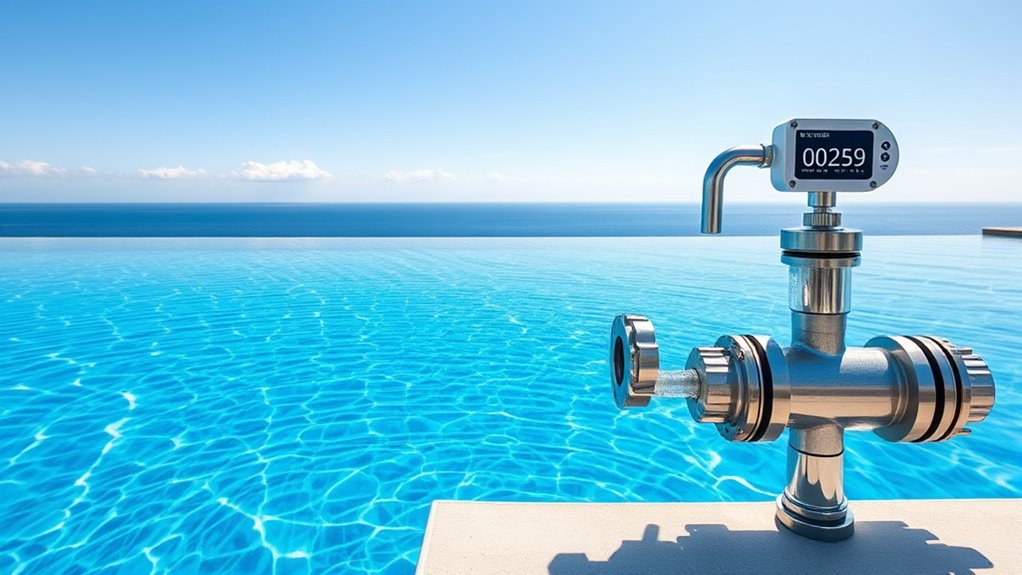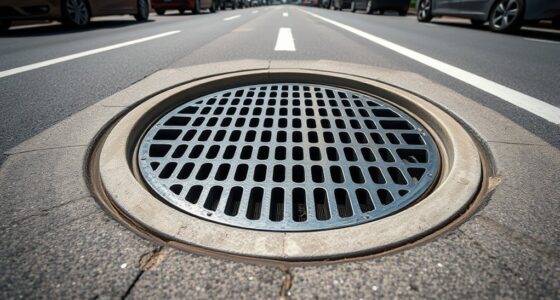To calculate infinity pool flow rates, first measure your pool’s dimensions to find its volume. Determine your desired turnover rate, typically between 4 to 8 hours, then divide the volume by that time to find your ideal flow rate. Adjust for pump efficiency, environmental factors, and system losses to get an accurate number. If you keep these steps in mind, you’ll set up a circulation system that runs smoothly and effectively. Keep exploring to learn more detailed calculations and tips.
Key Takeaways
- Calculate pool volume by measuring dimensions and dividing the pool into geometric sections if irregular.
- Determine desired turnover rate (e.g., 4-8 hours) to find required flow rate in GPH.
- Adjust flow rate calculations for pump efficiency losses using appropriate correction factors.
- Incorporate environmental factors like wind, temperature, and debris that may increase flow requirements.
- Monitor actual flow with flow meters and maintain system components to ensure optimal circulation performance.
Understanding the Basics of Infinity Pool Circulation

To keep an infinity pool functioning properly, understanding its circulation system is essential. You need to grasp how water flows continuously over the edge, creating that seamless visual effect. The circulation system includes pumps, pipes, and jets that move water from the pool into the catch basin below the infinity edge. The pump pulls water from the main pool, pushes it through the filtration system, and then returns it via jets near the edge. This cycle maintains water clarity and level, ensuring the infinity edge looks perfect. Proper circulation prevents stagnation, algae growth, and debris buildup. Learning how water moves through these components helps you optimize flow rates. Proper sizing of the circulation system ensures efficiency and longevity of the pool equipment. This knowledge forms the foundation for accurate calculations and efficient system design, keeping your infinity pool both stunning and functional.
Key Factors Influencing Flow Rate Calculations
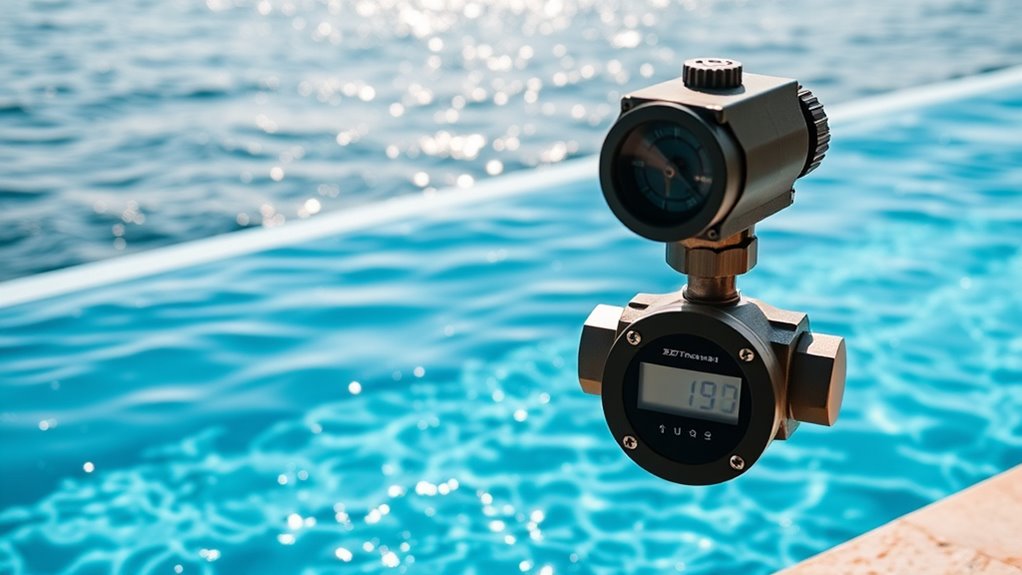
Several key factors directly impact the flow rate calculations for your infinity pool. First, the pool’s size and shape determine the volume that needs circulation, influencing how much water must move through the system. Second, the height difference between the pool and the filtration system affects the gravitational force, impacting flow speed. Third, pipe diameter and length are vital; larger, shorter pipes reduce resistance and allow faster flow. Fourth, pump efficiency and capacity set practical limits on how quickly water circulates. Fifth, environmental factors like temperature and debris can alter water viscosity and clog filters, affecting flow rates. Additionally, ensuring that the signs of spoilage are monitored in any equipment or materials involved can prevent malfunctions. By understanding these factors, you can more accurately calculate and optimize your pool’s circulation system for efficiency and safety.
Gathering Necessary Measurements and Data
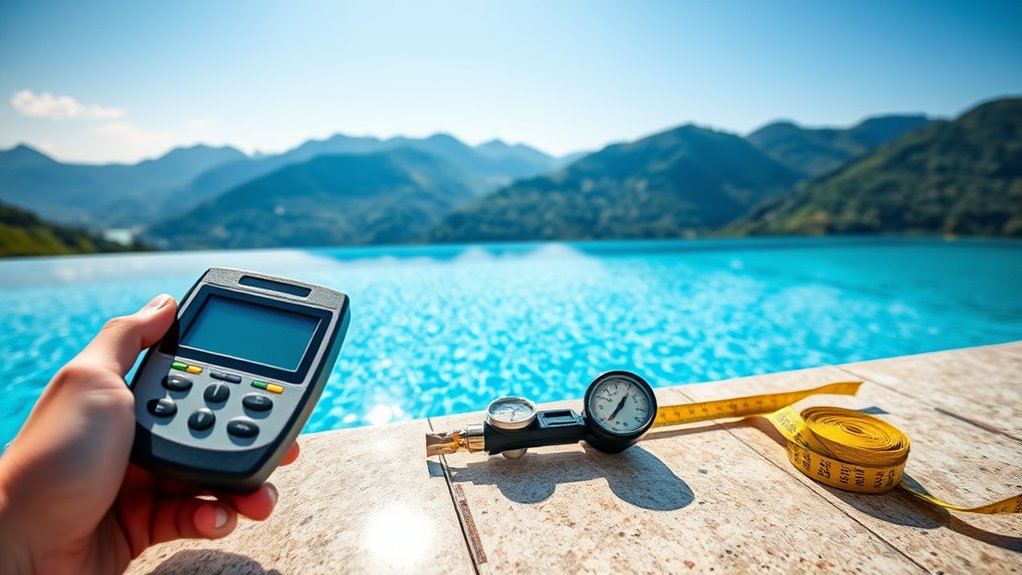
Before calculating your infinity pool’s flow rate, you need to gather accurate measurements of key variables. Measure the pool’s length, width, and average depth to determine its volume. Use a tape measure for length and width; for depth, take multiple readings at different points to account for slope. Record the height of the water level at rest, as well as the maximum and minimum water levels during operation. If your pool has features like a spillway or overflow edge, note their dimensions. Additionally, measure the height difference between the pool’s water surface and the catch basin or overflow point. Considering the impact of sleep on decision-making and precision can help ensure your measurements are accurate and reliable. Precise data guarantees your calculations are accurate and helps you determine the correct pump size and flow rate needed to maintain proper circulation.
Calculating the Pool’s Total Volume
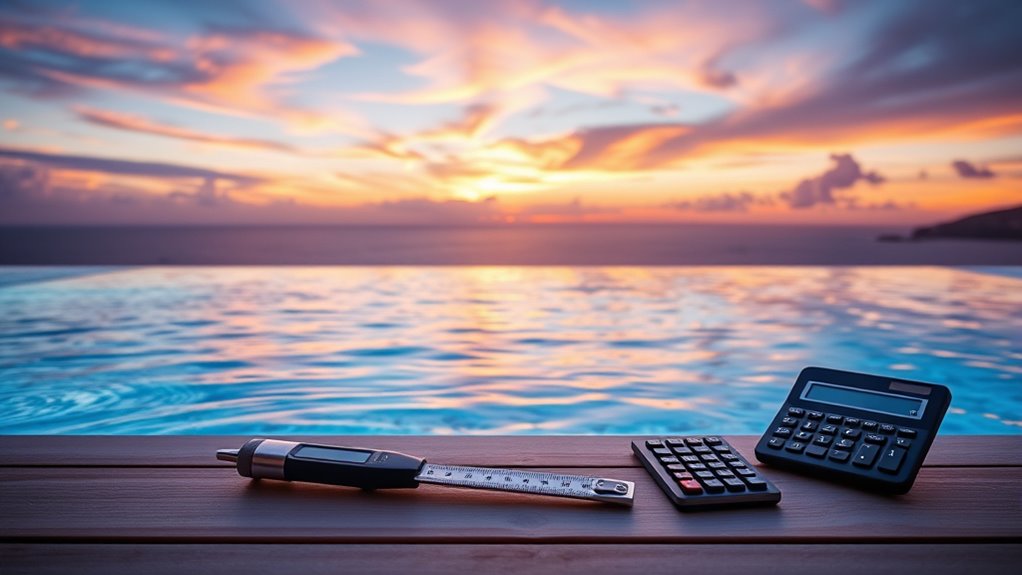
To find out how much water your pool holds, you need to determine its dimensions first. Then, use the appropriate volume formula based on the shape of your pool. Getting these calculations right is essential for accurate flow rate estimates.
Determine Pool Dimensions
Understanding how to determine your pool’s dimensions is essential for accurately calculating its total volume. First, measure the length, width, and average depth of your pool using a tape measure or laser scanner. For irregular shapes, break the pool into simpler geometric sections, and measure each segment individually. Record these measurements carefully, noting units to guarantee consistency. If your pool has a sloped bottom, measure the shallow and deep ends separately to get accurate depth averages. For a rectangular pool, multiply length by width by average depth to find volume. For more complex shapes, you might need to use additional formulas or tools like 3D modeling software. Precise measurements are key to ensuring your flow rate calculations are accurate and reliable. Additionally, understanding how pool dimensions impact flow rates can help you optimize your system for safety and efficiency.
Calculate Volume Formula
Calculating your pool’s total volume involves applying the appropriate formula based on its shape. For rectangular pools, multiply length × width × average depth. For circular pools, use π × radius² × average depth. If your pool has a more complex shape, break it into simpler sections and calculate each volume separately. For irregular shapes, approximate by dividing the pool into smaller, manageable sections with known formulas. Always measure your dimensions accurately, including depth at multiple points if it varies. Once you have these measurements, plug them into the correct formula to find the total volume in cubic feet or gallons. Knowing this volume helps you determine flow rates and filtration needs, ensuring your infinity pool operates efficiently and safely. Additionally, understanding AI in Business can assist in optimizing pool maintenance schedules through predictive analytics.
Determining the Desired Turnover Rate
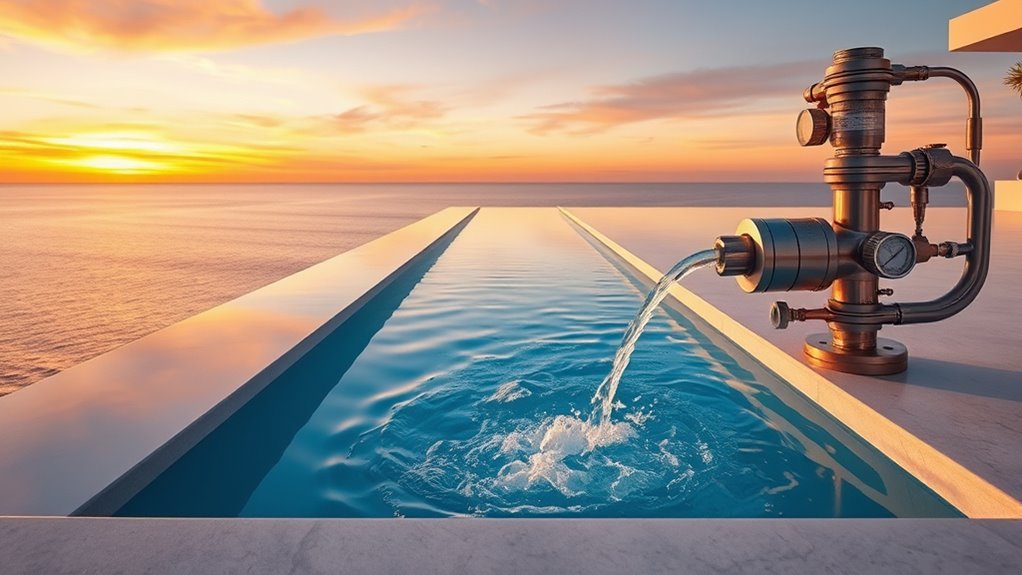
Choosing the right turnover rate is essential for maintaining a clean and healthy infinity pool. This rate indicates how many times the entire pool volume circulates through the filtration system each hour. To determine your ideal rate, consider factors like pool size, usage frequency, and local health guidelines. Most pools aim for a turnover rate between 4 and 8 hours, meaning the entire volume filters this often daily. For an infinity pool, you’ll want a rate that balances cleanliness with energy efficiency. If your pool gets heavy use or is in a warm climate, a faster turnover might be necessary. Conversely, for less frequent use, a slower rate could suffice. Clearly defining your preferred turnover rate helps you select the right pump and guarantees optimal water quality. Additionally, understanding filtration system components can help ensure your pool remains clear and hygienic.
Applying the Flow Rate Formula

Once you’ve established your desired turnover rate, applying the flow rate formula helps you determine the actual pump specifications needed to achieve it. The basic formula is Flow Rate = Pool Volume ÷ Turnover Time. First, convert your pool volume into gallons if it’s in another unit. Then, divide that volume by your target turnover time in hours to get the flow rate in gallons per hour (GPH). For instance, if your pool is 15,000 gallons and you want a turnover in 8 hours, divide 15,000 by 8 to get 1,875 GPH. This calculation tells you the minimum pump flow rate required. Use this number to select a pump that can comfortably meet or exceed this flow rate, ensuring proper circulation and filtration. Proper circulation is essential for maintaining water quality and preventing stagnation.
Adjusting for System Efficiency and Real-World Conditions

To get accurate flow rate estimates, you need to account for pump losses and environmental factors that can affect system performance. These real-world conditions often cause the actual flow to differ from your initial calculations. By adjusting for these variables, you’ll guarantee your infinity pool operates efficiently and reliably. Incorporating continuous evaluation of your system ensures sustained performance over time.
Accounting for Pump Losses
Even though calculations often assume ideal conditions, real-world systems experience losses that reduce overall efficiency. Pump losses occur due to factors like friction, motor inefficiencies, and pipe resistance. To account for this, you need to adjust your flow rate calculations with a pump efficiency factor. For example, a pump with 85% efficiency means you must increase your calculated flow to compensate for energy losses. Here’s a quick comparison:
| Pump Efficiency | Actual Flow Rate Needed | Adjustment Factor |
|---|---|---|
| 70% | 1.43 times baseline | 1.43 |
| 85% | 1.18 times baseline | 1.18 |
| 95% | 1.05 times baseline | 1.05 |
This guarantees your system delivers the desired flow, considering real-world pump performance. Incorporating system efficiency ensures more accurate and reliable flow rate calculations in practical applications.
Incorporating Environmental Factors
Environmental factors substantially impact the efficiency of your infinity pool system, making it essential to adjust your flow calculations accordingly. Factors like wind, temperature, and evaporation can reduce water flow or increase energy consumption. Wind can create turbulence, forcing you to increase pump flow rates to maintain the desired water level and flow. High temperatures may cause evaporation, requiring more frequent top-offs or higher flow rates to compensate. Cold weather can thicken water, affecting circulation efficiency. Additionally, debris and algae growth due to environmental exposure can clog filters, reducing system performance. To account for these factors, incorporate safety margins into your calculations and regularly monitor flow rates and water levels. Regular maintenance and filtration systems are crucial for managing debris and algae, ensuring optimal system performance. Adjustments ensure your system functions at its best under real-world conditions, maintaining the pool’s aesthetic and safety.
Practical Tips for Monitoring and Maintaining Flow Rates

Monitoring and maintaining flow rates in your infinity pool is essential to guarantee ideal circulation and prevent issues like uneven water levels or equipment strain. Regularly check your pump’s flow rate using a flow meter or by timing water movement through a known volume. Keep an eye on pressure gauges and listen for unusual sounds, which can indicate blockages or pump problems. Clean filters and skimmers frequently to ensure smooth water flow. Adjust valves carefully to maintain top-notch flow, especially after cleaning or repairs. Record flow rate readings periodically to detect trends or drops in performance. Always follow manufacturer guidelines for your pump and filter system. Consistent monitoring and prompt adjustments will help keep your infinity pool functioning efficiently and extend its lifespan.
Frequently Asked Questions
What Are Common Mistakes to Avoid When Calculating Flow Rates?
You should avoid common mistakes like using incorrect units, which can skew your results. Make sure to double-check your calculations and not overlook the pool’s specific dimensions or flow requirements. Don’t forget to account for factors like pipe friction or elevation changes, as they impact flow rates. Also, avoid rushing through steps—careful measurement and attention to detail help guarantee accurate calculations for your infinity pool.
How Often Should Flow Rates Be Re-Evaluated for Optimal Performance?
You should re-evaluate flow rates at least quarterly, like checking a car’s oil level to keep it running smoothly. Regular assessments ensure your infinity pool maintains ideal performance, preventing issues like water imbalance or equipment strain. If you notice fluctuations or changes in water clarity, recheck sooner. Consistent monitoring acts like a visual cue, helping you catch problems early and keep your pool flowing perfectly all year round.
Can Flow Rate Calculations Vary With Different Pool Shapes?
Yes, flow rate calculations can vary with different pool shapes. You’ll need to take into account the pool’s dimensions and shape because these factors influence water volume and flow dynamics. For example, a rectangular pool might have more straightforward calculations, while irregular shapes require adjustments for curves and angles. Always measure your specific pool shape accurately and adjust your flow rate calculations accordingly to guarantee optimal filtration and circulation.
What Tools or Software Can Assist in Flow Rate Calculations?
Think of tools and software as your digital compass guiding you through the complex landscape of flow rate calculations. You can use CAD software like AutoCAD or Revit to model your pool and simulate water flow. Specialized programs such as HEC-RAS or ANSYS Fluent provide detailed fluid dynamics analysis. Even spreadsheets with custom formulas can help you visualize and adjust flow rates, making your calculations as precise as a master sculptor carving marble.
How Do Weather Conditions Impact Flow Rate Requirements?
Weather conditions critically impact flow rate requirements for your infinity pool. Hot, sunny days increase evaporation, so you need higher flow rates to compensate for water loss and maintain water levels. Cold weather can cause freezing issues, requiring adjustments to prevent damage. Wind speeds can increase evaporation, demanding higher flow rates to keep water clean and balanced. Always monitor weather forecasts and adapt your system to guarantee ideal pool operation and water conservation.
Conclusion
Now that you’ve got the tools to calculate your infinity pool’s flow rate, think of it as tuning a delicate instrument—balance is key. With the right flow, your pool becomes a seamless mirror, reflecting perfection. Keep an eye on those numbers like a captain steering through calm waters, ensuring your infinity edge stays smooth and mesmerizing. Master this flow, and your pool will be a stunning masterpiece that invites endless admiration.

